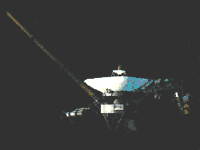Voyager
 The twin Voyager spacecraft were designed to perform close-up observations of the atmospheres, magnetospheres, rings, and
satellites of Jupiter and Saturn. The mission was originally designed to make a "Grand Tour" of all five outer planets, but was descoped due to funding limitations. However, following its planned encounter with Saturn, Voyager 2's planetary mission was
extended, and it was placed on a trajectory to allow flybys of Uranus and Neptune. Additional planetary flybys for Voyager 1 were sacrificed to permit better science observations at Saturn. Between them, Voyager 1 and 2 made numerous discoveries, including the discovery of new moons about several of the planets, Uranus' unique magnetic field, and the presence of volcanic activity on Io. Following their final planetary encounters, the vehicles began the Voyager Interstellar Mission (VIM), which will measure interstellar fields, particles, and waves to the outer limits of the Sun's sphere of influence, and possibly beyond. Both spacecraft will eventually depart our solar system and will travel towards other star systems. Each vehicle carries a gold phonograph record called "Sounds of
Earth", bearing messages, sounds, and pictures from our planet as greetings to any species who recovers the spacecraft. The cost of the Voyager 1 and 2 missions, including the spacecraft development, launch, and mission operations through the Neptune encounter, is $865 million. An additional $30 million was provided to fund the VIM for two years following the Neptune encounter.
The twin Voyager spacecraft were designed to perform close-up observations of the atmospheres, magnetospheres, rings, and
satellites of Jupiter and Saturn. The mission was originally designed to make a "Grand Tour" of all five outer planets, but was descoped due to funding limitations. However, following its planned encounter with Saturn, Voyager 2's planetary mission was
extended, and it was placed on a trajectory to allow flybys of Uranus and Neptune. Additional planetary flybys for Voyager 1 were sacrificed to permit better science observations at Saturn. Between them, Voyager 1 and 2 made numerous discoveries, including the discovery of new moons about several of the planets, Uranus' unique magnetic field, and the presence of volcanic activity on Io. Following their final planetary encounters, the vehicles began the Voyager Interstellar Mission (VIM), which will measure interstellar fields, particles, and waves to the outer limits of the Sun's sphere of influence, and possibly beyond. Both spacecraft will eventually depart our solar system and will travel towards other star systems. Each vehicle carries a gold phonograph record called "Sounds of
Earth", bearing messages, sounds, and pictures from our planet as greetings to any species who recovers the spacecraft. The cost of the Voyager 1 and 2 missions, including the spacecraft development, launch, and mission operations through the Neptune encounter, is $865 million. An additional $30 million was provided to fund the VIM for two years following the Neptune encounter.
Spacecraft
3-axis stabilized to within 0.1 deg. using hydrazine thrusters, star tracker, sun sensors, IRU. 10-sided bus mounted beneath 3.7 m high gain antenna houses most electronics. 3 RTGs produced 475 W at launch. X-band (4.8 to 21.6 kbps), S-band (40 bps) downlink to Deep Space Network. LGA for use during
emergencies. Digital tape recorder stores 500 Mbits. 13 m magnetometer boom. Remote sensing instruments mounted on 2 DOF pointing platform.
Payload
Imaging Science Subsystem (ISS) - two cameras for visible wavelength imaging. "Wide angle camera" has 200 mm focal length, 60 mm aperture; "Narrow angle camera" has 1500 mm focal length with 176 mm aperture. Both cameras equipped with 8 filters. Photopolarimeter Subsystem (PPS) - used to measure surface textures and compositions by detecting how light changes when reflected off of a surface. Infrared
Interferometer Spectrometer and Radiometer (IRIS) - used to measure surface temperatures, elemental composition of atmospheres and solid bodies, and the IR, visible, and UV energy reflected from solid bodies. Ultraviolet Spectrometer (UVS) - used to measure atmospheric elemental compositions and identify the presence of certain physical processes. Radio Science Subsystem (RSS) - uses the spacecraft telemetry system to measure atmospheric densities, temperatures, and pressures, as well as to estimate the width, shape, and thickness of planetary rings. Planetary Radio Astronomy (PRA) - measures RF signals emitted by the Sun and planetary systems. Plasma Wave Subsystem (PWS) - similar to the PRA, but works at different frequencies. Magnetometer (MAG) - measures solar and planetary magnetic fields. Plasma
Subsystem (PLS), Low Energy Charged Particle (LECP), Cosmic Ray Subsystem (CRS) (PPS) - three independent instruments that are used to detect charged particles in different energy ranges.
| Country of Origin | United States |
| Customer/User | NASA, JPL |
| Manufacturer(s) | JPL |
| Size | 3.7 m HGA, 13 m mag boom |
| Orbit | Solar system escape trajectory |
| Related Sites | Voyager Home Page at JPL |
Launch Facts
| Name | Int'l Desig. | Date | Site | Vehicle | Orbit | Mass(kg) |
| Notes | ||||||
| Voyager 2 | 1977-076A | 8/20/77 | ESMC | Titan 3E Centaur | SSET | 800 |
| Jupiter flyby 7/9/79, Saturn flyby 8/26/81, Uranus flyby 1/24/86, Neptune flyby 8/25/89 | ||||||
| Voyager 1 | 1977-084A | 9/5/77 | ESMC | Titan 3E Centaur | SSET | 800 |
| Jupiter flyby 3/5/79, Saturn flyby 11/12/80 | ||||||
Information in The Mission and Spacecraft Library is provided without warranty or guarantee. USE AT YOUR OWN RISK.